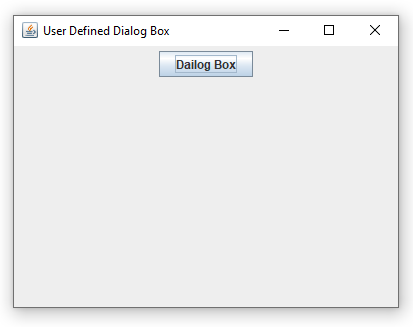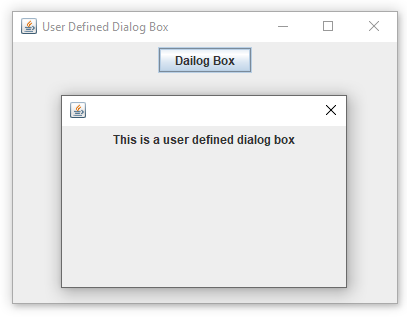java
User Defined Dialog Box in Java
User Defined Dialog Box in Java
Table of Contents
a) Introduction to User Defined Dialog Box
b) Steps for creating User Defined Dialog Box
c) Example with Source Code
d) Output
***********************
Introduction
In the previous chapter we discussed about the user defined dialog box theoretically. And in this chapter we are going to create the user defined dialog box.
The steps for creating
a user defined dialog box are;
a) JDialog class is used.
b) Two constructor are
there, they are: JDialog(JFrame parent, Boolean isModal) and JDialog(JFrame
parent, String title, Boolean isModal). You can use any one of them to create
user defined dialog box.
Note:
First constructor has two parameters and the value should be passed in the
constructor. The first parameter should be passed with parent frame and second
parameter should be passed with Boolean value that is either true or false.
As we know that Dialog
box is like a frame but it cannot execute independently. So we take help from
the parent frame. Creating a user defined dialog box is same like creating the
frame. Example;
JDialog d=new JDialog(f,true);
// size of dialog box
d.setSize(300,200);
// default close operation for dialog
box
d.setDefaultCloseOperation(JDialog.DISPOSE_ON_CLOSE);
// set layout to dialog box
d.setLayout(new FlowLayout());
l=new JLabel("This is a user
defined dialog box");
// add label to the dialog
d.add(l);
d.setVisible(true);
If you compare the
source code above with the frame its same. Let us see the example of user
defined dialog box with source code and output;
I have used the first
constructor i.e JDialog(JFrame parent, Boolean isModal)
and I have set the value isModal to “true”.
Source Code:
/*
A SWING GUI TO DEMONSTRATE THE USER
DEFINED DIALOG BOX.
*/
/**
*
* @author AnkitPC
*/
import javax.swing.*;
import java.awt.*;
import java.awt.event.*;
public class UserDefinedDialogBoxDemo
implements ActionListener{
JFrame f;
JButton b;
JDialog d;
// constructor
UserDefinedDialogBoxDemo(){
f=new JFrame("User Defined Dialog
Box");
f.setSize(400,300);
f.setDefaultCloseOperation(JFrame.EXIT_ON_CLOSE);
// set layout
f.setLayout(new FlowLayout());
b=new JButton("Dailog Box");
// register the event
b.addActionListener(this);
// add
component to the frame
f.add(b);
f.setVisible(true);
}
//main method
public static void main(String[] args) {
// call constructor
new UserDefinedDialogBoxDemo();
}
// overriding the method of Action Listener interface
public void actionPerformed(ActionEvent e){
JLabel l;
// first constructor with isModal true
d=new JDialog(f,true);
// size of dialog box
d.setSize(300,200);
// default close operation for dialog
box
d.setDefaultCloseOperation(JDialog.DISPOSE_ON_CLOSE);
// set layout to dialog box
d.setLayout(new FlowLayout());
l=new JLabel("This is a user
defined dialog box");
// add label to the dialog
d.add(l);
d.setVisible(true);
}
}
Note: Green Color words in the above program is comments.
Output:
Output:
The image below is the initial output of the
program.
As you know when the isModal
parameter has passed with value “true” then the
application will not allow accessing other parts of the application.
Just watch the video.
Now I have used the
second constructor i.e JDialog(JFrame parent,String title, Boolean isModal)
and I have set the value isModal to “false”.
Source Code:
/*
A SWING TO DEMONSTRATE THE USER DEFINED DIALOG BOX.
*/
/**
*
* @author AnkitPC
*/
import javax.swing.*;
import java.awt.*;
import java.awt.event.*;
public class UserDefinedDialogBoxDemo implements ActionListener{
JFrame f;
JButton b;
JDialog d;
// constructor
UserDefinedDialogBoxDemo(){
f=new
JFrame("User Defined Dialog Box");
f.setSize(400,300);
f.setDefaultCloseOperation(JFrame.EXIT_ON_CLOSE);
// set layout
f.setLayout(new
FlowLayout());
b=new
JButton("Dailog Box");
// register the
event
b.addActionListener(this);
// add component to the frame
f.add(b);
f.setVisible(true);
}
//main method
public static void
main(String[] args) {
// call constructor
new
UserDefinedDialogBoxDemo();
}
// overriding the
method of Action Listener interface
public void
actionPerformed(ActionEvent e){
JLabel l;
// second constructor with isModal true
d=new
JDialog(f,"Demo",false);
// size of dialog
box
d.setSize(300,200);
// default close
operation for dialog box
d.setDefaultCloseOperation(JDialog.DISPOSE_ON_CLOSE);
// set layout to
dialog box
d.setLayout(new
FlowLayout());
l=new JLabel("This is a user defined
dialog box");
// add label to
the dialog
d.add(l);
d.setVisible(true);
}
}
Note: Green Color words in the above program is comments.
Output:
Output:
The output you see I same because both program
source code is same only I have changed the constructor of the dialog box and
value of isModal, this is why I have used the video to show the difference.












Post a Comment
0 Comments